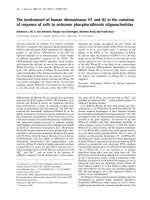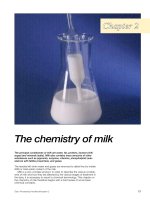chemistry of cells sem1
Bạn đang xem bản rút gọn của tài liệu. Xem và tải ngay bản đầy đủ của tài liệu tại đây (727.19 KB, 40 trang )
Chemistry of Cells
Chapter 2, Section 3
Objectives
1.
2.
3.
4.
5.
Describe the distinguishing characteristics of
carbohydrates
Describe the important biological functions of
polysaccharides
Explain what distinguishes lipids from other classes of
biological macromolecules
Describe the unique properties, building blocks and
biological roles of fats, phospholipids and steroids
Distinguish proteins from the other classes of
macromolecules
Objectives Cont.
6. List the biological functions which proteins
perform
7. Explain what determines protein conformation
and why it is important
8. Define denaturation and explain how proteins
may be denatured
9. Describe the characteristics that distinguish
nucleic acids from the other classes of
macromolecules
10. Summarize the functions of nucleic acids
Objectives Cont.
11. Briefly describe the three-dimensional
structure of DNA
12. Evaluate the importance of energy to
living things
13. Relate energy and chemical reactions
14. Describe the role of enzymes in chemical
reactions
15. Identify the effect of enzymes on food
molecules
MacroMolecules
• Macro = large
• Molecules = 2 or more atoms covalently
bonded
• Usually referred to as polymers
– Like a chain
• Made from several repeating subunits
– The repeated subunits are called monomers
– Like links in a chain
• 3 of the 4 macromolecules are polymers of
monomers
Making or Breaking Polymers
• The chemical mechanisms that cells use
to make and break polymers are similar for
all classes of macromolecules.
Making Polymers
• Monomers are connected
by covalent bonds via a
condensation reaction
or dehydration reaction.
– One monomer provides
a hydroxyl group and
the other provides a
hydrogen and together
these form water.
– This process requires
energy and is aided
by enzymes.
Breaking Down Polymers
•
The covalent bonds
connecting monomers in a
polymer are disassembled by
hydrolysis.
– In hydrolysis as the covalent
bond is broken a hydrogen
atom and hydroxyl group from
a split water molecule
attaches where the covalent
bond used to be.
– Hydrolysis reactions
dominate the
digestive process,
guided by specific
enzymes.
Types of Macromolecules
There are four of them.
1. Carbohydrates
2. Lipids
3. Proteins
4. Nucleic acids
☺ For each of these you will be expected to
identify, describe, and differentiate between all
four macromolecules.
☺You will also be expected to describe the
biological importance of each macromolecule
Function of Carbohydrates
1. Sugars, the smallest carbohydrates,
serve as fuel and carbon sources
2. Polysaccharides, the polymers of
sugars, have storage and structural
roles
Structure of Carbohydrates
• Monosaccharides generally have
molecular formulas containing C,H and O
in a 1:2:1 ratio.
– For example, glucose has the formula C6H12O6.
– Most names for sugars end in -ose.
• Monosaccharides are also classified by
the number of carbons in the backbone.
•
Monosaccharides, particularly glucose, are a major fuel for cellular
work.
• They are also building blocks for of other monomers, including
those of amino acids (protein) and fatty acids (lipids).
•
in aqueous
solutions monosaccharides form rings.
While often drawn as a linear skeleton,
2. Polysaccharides, the polymers of
sugars, have storage and structural roles
• Polysaccharides are polymers of
hundreds to thousands of
monosaccharides joined together (What is
a polymer?)
• One function of polysaccharides is energy
storage
– it is hydrolyzed as needed.
• Other polysaccharides serve as building
materials for the cell or whole organism.
• Starch is a storage polysaccharide
composed entirely of glucose monomers
– Great big chain of glucose molecules
– What would this look like? (Draw it.)
Biological Uses of Polysaccharides
• Plants store starch within plastids, including
chloroplasts.
• Plants can store surplus glucose in starch and
withdraw it when needed for energy or carbon.
• Animals that feed on plants, especially parts rich
in starch, can also access this starch to support
their own metabolism.
• Hey, this sounds like an objective!
Lipids - Diverse Hydrophobic
Molecules
1. Fats store large amounts of energy
2. Phospholipids are major components
of cell membranes
3. Steroids include cholesterol and
certain hormones
Introduction
• Lipids are an exception among macromolecules
because they do not have polymers.
– Though lipid structure is easily recognized
• Lipids all have little or no affinity for water.
• Lipids are highly diverse in form and function.
1. Fats store large amounts of
energy
• Although fats are not strictly polymers,
they are large molecules assembled from
smaller molecules by dehydration
reactions.
• A fat is constructed from two kinds of
smaller molecules, glycerol and fatty
acids.
• Glycerol consists of a three carbon skeleton with
a hydroxyl group attached to each.
• • A fatty acid consists of a carboxyl group
attached to a long carbon skeleton, often 16 to
18 carbons long.
• The many nonpolar C-H bonds in the long
hydrocarbon skeleton make fats hydrophobic.
• In a fat, three fatty acids are joined to glycerol by
an ester linkage, creating a triacylglycerol.
• The three fatty acids in a fat can be the same or
different.
• Fatty acids may vary in length (number of
carbons) and in the number and locations of
double bonds.
• If there are no
carbon-carbon
double bonds,
then the molecule
is a saturated fatty
acid - a hydrogen
at every possible
position.
• If there are one or more carbon-carbon double
bonds, then the molecule is an unsaturated
fatty acid - formed by the removal of hydrogen
atoms from the carbon skeleton.
• Saturated fatty acids
are straight chains,
but unsaturated fatty
acids have a kink
wherever there is
a double bond
Saturated vs Unsaturated
• Fats with saturated fatty acids are saturated fats.
– Most animal fats
– solid at room temperature.
–
• Straight chains allow many hydrogen bonds
A diet rich in saturated fats may contribute to cardiovascular
disease (atherosclerosis) through plaque deposits.
• Fats with unsaturated fatty acids are unsaturated
fats.
– Plant and fish fats, known as oils
– Liquid are room temperature.
•
The kinks provided by the double bonds prevent the molecules from packing
tightly together.









